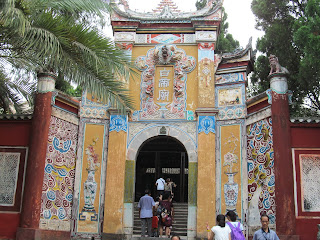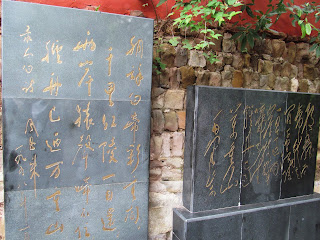I
embarked on the Victoria 2 Wednesday evening. After checking in, I relaxed in
my air conditioned room for over an hour.
I was surprised at how nice the room
was. In addition to being spacious, every room has a small balcony. Then I went
out to explore the ship. There’s not much to see, as it’s a basic ship without
many extras. I went to the top deck and was exercising there when Leo, the
social coordinator, came to take me down for his orientation for English
speakers. There were five of us: two young women from England and an Italian couple.
There were 145 Chinese passengers. After the orientation, I returned to my room
to have it confirmed that I did, indeed, not have a roommate. I had booked a
room to share with another female to avoid paying the 75% single supplement and
had wondered whether there would be one. So I had the room to myself.
At 9:00
PM, the ship set sail. I went to the top deck to watch us leave and to see the
view of the city lights from the river. There were about 50 others on deck,
too. It was fun to watch the city disappear as we moved down the river.
At 6:30
Thursday morning, morning music began so we would wake up for breakfast at
7:00. Meals were served buffet style and included both Western and Chinese
food. As we expected, the five foreigners were assigned to sit together along
with three Chinese passengers. When I approached the table, it was obvious
which seats were for the foreigners, as there were five sets of utensils and
three sets of chopsticks. We asked for chopsticks, and after a few meals, they
were put on the lazy Susan for us, but we always had utensils, not chopsticks,
at our places.
At 8:00
we disembarked for our tour to Fengdu, the city of ghosts. This was the only
included shore excursion on the trip. There was an English-speaking guide for
the five of us. She was very good—spoke English well and provided a lot of
information. Fengdu is the home of ghosts/spirits. According to legend, it is
where the devil lives. Good spirits go to heaven, and evil goes to Fengdu. It
is built on a hill with the main pagoda at the top.
Outside the bottom entrance
is a statue of the spirit of good. Kindness is the way to have a good life and
avoid hell. The spiritual focus is Taoism. Pillows before altars have the yin/yang
symbol. Yin is female and evil; yang is male and good.
At the
top of another hill is a statue of the head of the Jade Emperor.
In one
place there are three bridges. In the middle is the Bridge over Troubled
Waters. This is the path for entering the area. You should take an odd number
of steps over the bridge. As we crossed the bridge, a photo was taken of each
of us. When leaving, you can cross on the silver bridge or the gold bridge. The
silver one is for wealth; the gold one is for longevity. Our guide suggested a
third way to cross for good health: walk over the gold bridge taking as many
steps as possible. We all followed her.
Going
up the path to the top temple and pagoda there are demon guardians on both
sides. After visiting one temple, you walk along a street and are not to look
back. When entering gate, men stepped over with their left foot, women with their
right.
One
building features hell. There are demons guarding the image of the king of the
dead.
On the sides of the central altar are the torture chambers. These depict all kinds of tortures in hell.
Originally
built about 2000 years ago, most of the buildings in Fengdu were reconstructed
in the 1980s after being destroyed during the Cultural Revolution. Our guide
used this terminology; a sign referred to it as the middle of the ___. (I
forget the words used to refer to that period of time.) The Jade Emperor and
another building were just completed in 2011.
A
special symbol of Fengdu is a character found only there. It combines the
characters for “only kindness makes peace.” If you purchased the photo taken of
you crossing the Bridge over Troubled Waters, you also got a keychain with this
character. I decided to purchase the photo, which I usually don’t do.
The original
city Fengdu was flooded when the dam was completed and is now underwater. On
the opposite side of the river is new Fengdu, where people who were displaced
by the changed river live now.
The
river is low now for the summer season. This is controlled by the dam so that
there will not be flooding during the rainy season. In winter, it is much
higher.
Before
lunch we had the captain’s welcome reception. Everyone was given free
champagne, and there were snacks. I sat with the Italians. A Chinese family
came over to do welcome toasts. The woman had her son, age 10, tell us about
Guanzhou, their home.
After
lunch and relaxing on the boat for a few hours, it was time for the optional
afternoon tour to Shibaozhai. That one hadn’t been listed in my itinerary, but
I decided to go. The temple on top of the cliff was built in 1572. Ninety years
later (1662), the pagoda was built in on the side of the cliff as a way to get
up to the temple. The two structures have a total of ten levels, which become
smaller as they go up. The circular staircase also becomes narrower. We didn’t
go to the very top level, as only a few people could be there at once and it
was time to return to the boat.
The
structures were built with no nails, making Shibaozhai one of the world’s eight
largest singular construction buildings. They are also among the oldest
buildings in China to have survived without being reconstructed. To get to the
pagoda, there is a long, wide suspension bridge that shook when the crowd of
people walked on it.
As the river rises over the years, the pagoda will be
flooded. So the local people have built a barrier to protect it from flooding.
There’s
a small temple on the island. It has a special bridge here has a very steep
arch. It should be crossed with three, six, or nine steps. This takes some
planning, as it takes one large step to get onto the bridge.
The
tour was interesting, but it was especially crowded at the pagoda. More people
arrived after we did; so climbing up the pagoda was rushed. There wasn’t time
to really look around. However, it wasn’t so crowded when we walked over the
bridge and to the bottom of the pagoda; so that was good. From the top, I could
see a steady stream of people crossing the bridge. We passed a number of
foreigners, who were probably doing the river cruise as part of a China tour, which
made me glad I was with my small Chinese group. Tillie, whom we had met at the
reception, walked and chatted with me part of the way up. She used to be an
English teacher and is now a department secretary and teaches a little.
Later I
met David, age 10. He wanted to ask if I would take a photo with him but
couldn’t quite do it. So I helped him, and his father took a photo. Then he
walked with me the rest of the time. When we were going up the stairs, he took
my arm to assist me. He wanted to take a couple photos of me for me; so I let
him, as this is important to Chinese people. His English is good enough that we
were able to chat quite a bit. It’s experiences like these that make me happy
to be with this group.
Friday
morning wake up was at 6:15. I joined the group going on the optional tour to
White Emperor City. (Those who didn’t join the tour could sleep half an hour
longer.) This was the optional tour I knew about. Again, I was the only
foreigner from the ship to go, but I joined a group from another ship. They
were a Chinese-American family and a couple from El Salvador and Colombia. They
said there were other foreigners on their ship, but they didn’t join the tour.
When we disembarked, we walked up the stairs to get to the top of the cliff.
Fortunately, after ascending a few sets of stairs—about half way up, there were
escalators to the top. There we walked along the inside of the wall. The
original, 600-year-old city gate is there. It was going to be submerged in the
flooding after the dam was built; so they took it apart and rebuilt it at the
higher level.
The
“city” is on an island, which was a peninsula prior to the dam. Now it is
connected to the mainland by a long bridge.
From the bridge we had good views
of the Yangtze to one side and another river that branches off it to the other.
It was a hazy morning, which added to the atmosphere but made photography
difficult.
After
walking uphill and across the small island, we were at the viewpoint from which
we could see the view that is on the back of the 10 yuan note. It’s the first
of the Three Gorges and is considered to be the most beautiful. However, since
it was hazy, it was not the most beautiful like in the picture, but it had a
different kind of beauty.
Our
guide told us that the white emperor is a story about a white dragon that
turned itself into a general. Realizing that this man was really not a man,
another general declared himself to be the emperor and called himself the White
Emperor. The brochure says that someone reported seeing a white dragon, which
is a symbol for the emperor and then a warlord declared himself to be the
emperor, calling himself the White Emperor. It is also said that the city was
once covered by a white mist, like an emperor should be. This is a very revered
story in Chinese history; so the site is very important to the Chinese. It was
crowded with Chinese tourists.
The
temple is at the top of the mountain. Up 300 steps, and this is after walking
up to the steps to get there . The white town (Baidi Town) was written about by
many famous poets.
Outside the temple gate there is a poem written in Mao’s
calligraphy and one in Zhou Enlai’s calligraphy.



























No comments:
Post a Comment